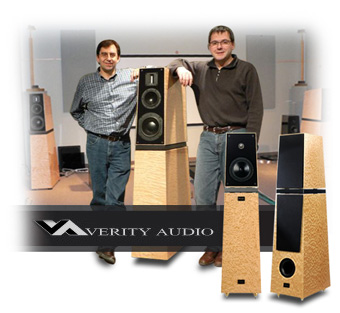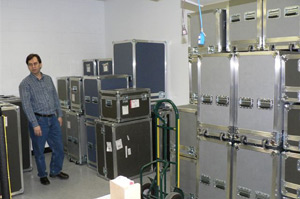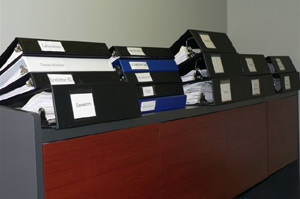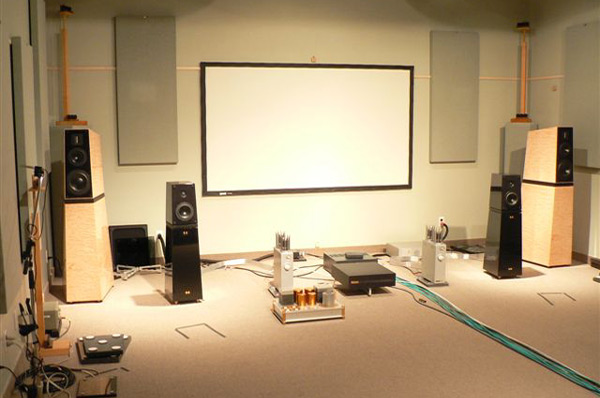![[SoundStage!]](../../titles/sslogo3.gif) Home
Audio Equipment Home
Audio EquipmentFeature Review |
|||||||||||
Verity Audio, in contrast, started with one very good product, made as well as they could make it, and has carefully and deliberately matured that same product whenever ideas or materials have presented themselves. In constant production since 1995, the Parsifal, which retails for $19,495 USD per pair in its current Ovation iteration, has received three separate updates, but the changes have been subtle and evolutionary. The cabinet dimensions have remained essentially the same, which means the Parsifal's graceful, room-friendly proportions have also remained unaltered. Upon its introduction, the Parsifal used a 1" Scan-Speak soft-soft dome tweeter. The midrange and bass drivers consisted of custom-built 5" and 8" AudioTechnology numbers. The Parsifal has retained these drivers since its inception, with modifications aimed at increasing transparency and bass response. In 1998, the second generation of the speaker, the Parsifal Encore, was born. Modifications included a custom-made Scan-Speak tweeter to replace the off-the-shelf version in the original speaker, and a 4-ohm woofer in place of the 8-ohm unit of the original. By all reports, the original Parsifal was a critical success, and Verity Audio wisely decided not to mess with the basic formula. The Parsifal Encore soldiered on without change for four years. In 2002, Scan-Speak introduced a new version of the Parsifal Encore’s soft-dome tweeter. Verity Audio decided that the more extended highs were a worthy addition but not significant enough to warrant a new model name. May of 2005 saw the Parsifal Encore receive a substantial overhaul to its current iteration. The latest generation of Scan-Speak tweeter, which the Parsifal Ovation employs, now features extension reportedly to over 50kHz. The bass cabinet has grown slightly, although it retains its familiar compact proportions. The cabinet is still ported, but the port has grown significantly in both width and length. The crossover has been redesigned in order to accommodate these modifications. But this is all general stuff that you can read about in product literature. To find out how the newest Parsifal is made, I made the trek to Verity Audio on a soggy Friday in May, shortly after its introduction. The company is located in a modest industrial park in a suburb of Quebec City (which, incidentally, is a UNESCO heritage site and the only walled city in North America). The facility itself is of a reasonable size -- 5000 square feet. My first impression was of neat, orderly efficiency. All tools and equipment were smartly stored; there were no scraps or open boxes in evidence, not even any dust on shelves or workspaces. I know -- I checked when Bruno Bouchard and Julien Pelchat, Verity's co-CEOs and chief designers, weren't looking. Although they may have just cleaned up in preparation for my arrival, I don't think that this was the case. The looks of the factory fits in with the overall Verity gestalt -- nothing left to chance, no rash or wasteful inefficiencies. Verity's facility supports research and development, assembly, and listening and evaluation processes. In the course of the tour, Bruno Bouchard explained that all of the bass and midrange drivers used in Verity's speakers are custom-designed and -manufactured by AudioTechnology, a Danish company whose founder is responsible in part for both Dynaudio and Scan-Speak. Bruno showed me two woofers, one being an off-the-shelf version and the other a custom version used in the Sarastro, the speaker directly above the Parsifal in Verity's product line. He explained that the Theile-Small parameters, which define the electrical and mechanical characteristics of midrange and bass drivers and tell designers far more about their real performance than their size, power ratings and sensitivity, of the Verity driver were specifically chosen for its particular application, which meant that the entire driver had to be custom-made. Visually, it was immediately apparent that the Verity driver was a completely different animal, with a massive magnet structure which dwarfed that of the stock driver. Verity uses first-order crossovers employing minimal components. Complicating driver selection further, midranges are allowed to run up to their natural high-end limits, and no notch filters are used to correct frequency or phase anomalies. Each of these design choices has its own difficulties, and combined together they present a formidable challenge for any driver. According to Bruno and Julien, their partnership with AudioTechnology has allowed them to jointly design drivers that can overcome these obstacles and permit the creation of extremely coherent loudspeakers. The R&D area contained shelves that were littered with drivers that had been evaluated for use in Verity speakers but had been deemed inferior to those currently in service. Although the Parsifal is rarely changed, it's not because Bruno and Julien rest on their laurels. Instead, it seems that they have chosen their drivers well. Measure twice, cut once. Every revision to every Verity product is carefully recorded in a binder specific to that speaker line -- evidence of the thoughtful care that's given to each and every change. Further, the Theile and Small parameters of every driver in every Verity speaker are kept in their own database. Each driver set is hand-matched before the speaker pair leaves the factory, and should a driver need replacement in the future, Verity can refer back to the parameters of its mate and replace it with one of identical specifications.
Part of the answer: The cabinets for all of Verity's speakers are made and finished in an independent woodworking factory in New Brunswick. Verity has been using the same source for cabinets for ten years. While Bruno and Julien have tried other woodworkers, the complex design of Verity's speakers combined with the precise tolerances resulted in such a steep learning curve that it became far easier to remain with their original source. Once the cabinets are completed, the real fun begins. If you've ever seen Verity speakers in the flesh, you've no doubt been taken aback by the finish. That's real Italian polyester lacquer, and many coats of it. This hand-rubbed finish is very difficult and expensive to apply. Consisting of a mixture that includes peroxide and cobalt, which are very reactive -- read: explosive -- when mixed, the polyester resin is in a 90% solid form, and must be applied within minutes of being prepared. The piano black lacquer, while absolutely beautiful and completely flawless, pales beside the quilted big leaf maple veneer that adorned a pair of Sarastros. Julien wouldn't disclose exactly how much it cost to veneer a pair of these fairly large speakers in this exotic wood, but he did tell me that he can’t bring himself to throw out some of the veneer scraps he has lying around. In order to justify this hoarding, he said that he's in the process of trying to dream up a project that would use up some of these mismatched pieces. Upon the cabinets' arrival at Verity, the man whom Julien describes as "one of the most anally retentive people alive" examines them. This man, who's in charge of quality control, often rejects cabinets with flaws that are invisible to Julien. However his decision sticks, and the rejects are returned to be refinished, and will hopefully return to pass scrutiny another day. Before the finished speaker leaves the factory, it's given one last coat of wax and a polish. Such an impressive cabinet deserves better-than-wood shipping crates or -- gulp -- cardboard boxes, and Verity delivers. Stacked up in one corner of the room were the custom-made flight cases in which all Verity speakers ship. Both Bruno and Julien have pro-audio backgrounds, which means that they've had plenty of experience packing and unpacking gear. In the pro-audio world, cardboard just doesn't cut it, and Verity believes that the same should hold true for home audio. According to Bruno and Julien, these custom-made cases don't add a significant percentage to the finished cost of Verity speakers, but do add a healthy dollop of pride of ownership. What started off as a businesslike factory tour quickly degenerated into a daylong listening session. Verity's listening room is, without a doubt, the finest dedicated room I've ever been in. First off, it's quite large -- at least 30' long, by 18' wide, with an 11' ceiling -- and has acoustical treatments tastefully integrated into the decor. The wall behind us was taken up with CD and record racks, which is a far better acoustical treatment than any store-bought item, something I found out when I moved my record rack to behind my couch.
And then there was the equipment. What a set of components! If someone served me a dCS digital stack with hollandaise sauce for dinner, I believe I could eat it in one sitting. This luxury-level source fed a Nagra PLP preamp, which in turn sent its signal to Nagra VPA mono tube amplifiers. The analog source consisted of a Clearaudio Reference ‘table, Graham 2.2 tonearm and Benz LP ebony cartridge. Cables varied among Nordost Valhalla, Nirvana S-L, and Discovery Signature or Plus, depending on which components were currently in use. The Parsifal Ovations, the same pair that would be arriving at my house in a few weeks, looked lost down at the other end of the room. As I said, the room was quite large, and the Parsifal Ovation is a reasonably compact floorstanding speaker. However, any doubts about compatibility were quickly dispelled with the first deep, enveloping bass note. We spent the rest of the day doing the "Have you ever heard this one?" dance, playing music as diverse as Hendrix and the Weavers, focusing on some of the many Classic Records LPs that Bruno and Julien have hoarded. So wrapped up in the music were we that we didn't bother stopping for lunch. We subsisted instead on coffee dispensed from Verity's on-site espresso machine. I think what impressed me most about the sound that I experienced was how much it resembled what I heard many times at shows. While hotel rooms converted into impromptu listening studios are often responsible for some of the most miserable demo environments imaginable, it slowly dawned on me that every room in which I'd heard Verity speakers managed to produce consistent sound. Now, here in a room that was set up optimally, according to the speaker’s own designers, I was hearing that same thing: deep, tight, visceral bass; a smooth, uncolored midrange; extended but totally relaxed highs; and superb imaging. In all, the sonic evenness of these wildly different rooms and systems was uncanny, and it pointed to a speaker that worked with its surroundings, not against them. Now, all we had to do was transport that experience back to my listening room in Toronto. Stay tuned. ...Jason Thorpe
|
|||||||||||
|
|||||||||||
![[SoundStage!]](../../titles/sslogo3.gif) All
Contents All
ContentsCopyright © 2005 SoundStage! All Rights Reserved |







